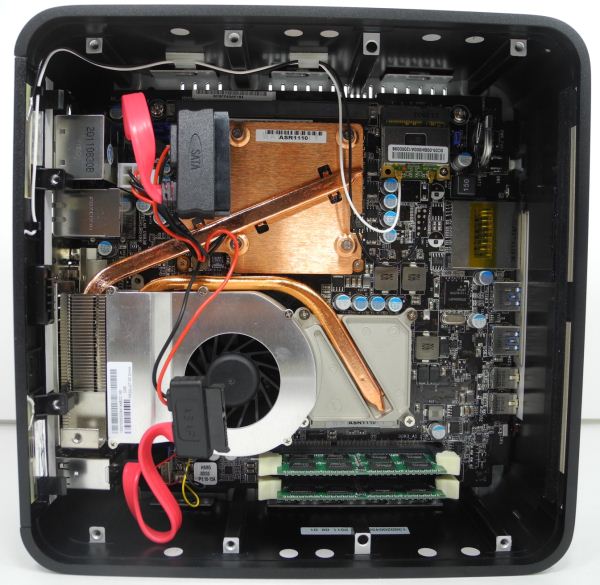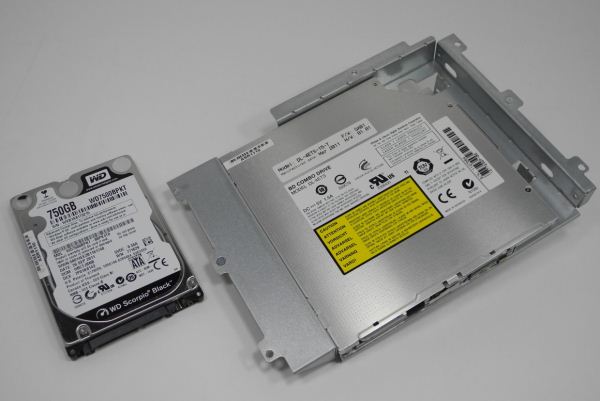ASRock's High-End Vision 3D 252B HTPC Review
by Ganesh T S on May 7, 2012 6:15 AM EST- Posted in
- Home Theater
- Sandy Bridge
- HTPC
- GT 540M
- NVIDIA
The ASRock Vision 3D 252B is primarily built out of notebook components, and it is not possible for the average enthusiast to build such a system with off-the-shelf components.
Motherboard & Chipset : mini-ITX Intel HM65-MXM
The motherboard used in the Vision 3D series is based on the Cougar Point Intel HM65 chipset. The 2 SATA 6 Gbps ports are available as headers on the motherboard, while one SATA 3 Gbps port is made available as an eSATA3 port. Another SATA port is available as a header on the motherboard (it is connected to the Blu-ray drive).
The mini PCI-E slot is taken up by the Atheros based AzureWave WLAN module. The two sides of the Vision 3D chassis are used as antennae. The two DIMM slots are on the right side of the board, next to the CPU. There is also a MXM slot in which the GT 540M MXM module is plugged in.
CPU : Intel Core i5-2520M
The Core i5-2520M is a 35W TDP processor belonging to the 32nm Intel Sandy Bridge family. Clocking in at 2.50 GHz, it is capable of going up to 3.2 GHz for a single core and 3.0 GHz for both the cores in turbo mode. 3MB of Intel Smart Cache is shared between the two cores and the integrated GPU.
Integrated GPU : Intel HD Graphics 3000
The integrated GPU in the Sandy Bridge processors come in two varieties, namely, HD Graphics 2000 and HD Graphics 3000. The Core i5-2520M uses the latter. It has a base frequency of 650 MHz, and is capable of going up to 1.3 GHz in stressful conditions. It supports full 3D video capabilities, QuickSync and WiDi. However, WiDi is not supported by the CoreHT 252B. WiDi makes sense for laptops, but not much for SFF HTPCs. So, we don't fault ASRock for avoiding this feature. Since we also have a discrete GPU in the system, Virtu from LucidLogix is necessary for users to be able to take advantage of the HD 3000's capabilities. The Vision 3D 252B's BIOS comes with a license for Virtu. Most users will be using Virtu to take advantage of QuickSync.
Discrete GPU : NVIDIA GT 540M
The MXM module in the Vision 3D 252B is the NVIDIA GT 540M. This is a slight step up from the GT 425M used in the first generation Vision 3D 137B.
DRAM : ASInt 2 x 4GB DDR3-1333
ASRock has used a relatively new memory vendor in ASInt for the CoreHT 252B. The memory chips operate with a 9-9-9 CAS latency.
Hard Disk : Western Digital Scorpio Black 750GB 7200 rpm 2.5"
The 750GB Scorpio Black is one of the best reviewed hard disks in its class. It has been reviewed to have upto 120 MBps sequential read speeds.
The hard disk is a good choice with respect to the price - performance ratio for the ASRock Vision 3D 252B.
Optical Disk Drive : Philips Lite-on Blu-ray / DVD RW Slot Loading Drive
The ASRock Vision 3D 252B ships with the Philips Lite-on DS-4ETS BD Combo Drive. This is a slot loading drive similar to the one in the first generation Vision 3D, befitting a high end premium HTPC.
MCE Remote
One of the shortcomings of the ASRock HTPCs when compared with something like the Zinos from Dell is the absence of a wireless keyboard / mouse combo. However, ASRock does take care to ensure the presence of an IR receiver in the system and also bundle a MCE remote.
The MCE remote bundled with this system is the same as that of the CoreHT 252B. When the CoreHT 252B shipped with the same remote as the Vision 3D first generation unit, we thought the second generation Vision 3D would also get a step up. Unfortunately, that is not the case.
As we have noted before, the quality of the MCE remote is a big letdown. The keys are quite small and the unit feels cheap in the hand despite being pretty decent in appearance.
In the next few sections, we will take a look at the performance of the ASRock Vision 3D 252B.













60 Comments
View All Comments
Southernsharky - Monday, May 7, 2012 - link
As other people have noted, you could just buy a laptop with almost all of these specs, except for the 750 gb HD for 1/2 this price. You could buy a quad core laptop and an external hard drive for less than $800. This product screams rip off.blackbrrd - Monday, May 7, 2012 - link
You can get 1tb laptop hdds for around 100$, so that's not really a problemBPB - Monday, May 7, 2012 - link
My issue would then be speed. You can get 1TB notebook drives cheaper these days, but the speed is 5200rpm and 5400rpm. I wonder how they would handle recording 3 HD shows?blackbrrd - Monday, May 7, 2012 - link
A typical HD movie of 2 hours takes maybe 4gb which comes down to about 0.5mbyte/s. Writing three hd streams at a time (1.5mbyte/s) shouldn't be a problem. I haven't tried it though.seanleeforever - Wednesday, May 9, 2012 - link
A typical HD movie of 2 hours takes maybe 4gb which comes down to about 0.5mbyte/s.how about 3 times as much? at 4GB you are talking about DVD quality, which is no where near HD level.
lenkiatleong - Monday, May 7, 2012 - link
I am puzzle how you can bitstream HD audio via optical as quoted "..when playing back a 1080p24 Blu-ray movie from the optical drive with HD audio bistreaming.". Do you mean Dolby TrueHD and DTS HD Master?Another question is, can the HDMI bitsream Dolby TrueHD and DTS HD master using PowerDVD 12 to your AV?
ganeshts - Monday, May 7, 2012 - link
Yes, the HDMI can bitstream HD audio using PDVD 12. Of course, through optical SPDIF, only Dolby DIgital and DTS can be bistreamed. Note that when I mentioned optical drive, I meant the Blu-ray drive as opposed to something from the hard disk or an externally attached hard drive / over the network.lenkiatleong - Tuesday, May 8, 2012 - link
Thank you for the clarification. There is another thing which i have in doubt from day one. It would be good if you could enlighten us.The question: Is there any difference if one uses HTPC like this AsRock (bluray ISO source or optical drive, PDVD12 and HDMI) to feed HD audio (Dolby TrueHD or DTS HD Master) and HD video to mid/high end AV as compare to using average bluray player in the market?
ganeshts - Wednesday, May 9, 2012 - link
In most cases, no. The reason is that you are at the mercy of NVIDIA drivers for certain functionality, and if they get broken in a certain driver release, you might not get perfect output (scaling from 4:2:0 Blu-ray video to 4:2:2 / 4:4:4 needed by HDMI for transportation may be achieved by different algorithms in the case of hardware Blu-ray players / even the NVIDIA driver algorithm might not be perfect). Note that a hardware player itself is not guaranteed to do this properly either.DerPuppy - Monday, May 7, 2012 - link
Not sure if I'm a little behind somewhere, but is there a simple/straightforward guide to configuring a media player like MPC-HC somewhere for one to peruse in the interest of properly configuring a media center? or would anandtech be interested in creating or maintaining one?